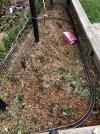JungleSkipper
Registered
Hi,
I’m just getting started with g-scale and mode railways. I am looking at building a small loop in a backgarden flower bed for my son. I have the train and the track, but I am a bit confused about whether I need other things/best practices.
My layout looks like this:

It’s pretty simple. I have bought some timber to raise it off the ground (any particular height?). I plan on using some posts and the curve the timber around the posts.
Are there any best practices I should be thinking of, especially creating an outdoor track to last for a long time?
I have a couple of probably really simple questions which I can’t find an answer to:
- what are rail joiners and do I need them?
- how do you attach the track to the wood, I was thinking of nailing it in but is there a better way?
- how do you house the power supply? The track power cables don’t look that robust for a permanent in
If I’m allowed I’m hoping to break through the wood at the end and go around the rest of the garden with 2 reversing loops.
Many thanks
Daniel
I’m just getting started with g-scale and mode railways. I am looking at building a small loop in a backgarden flower bed for my son. I have the train and the track, but I am a bit confused about whether I need other things/best practices.
My layout looks like this:

It’s pretty simple. I have bought some timber to raise it off the ground (any particular height?). I plan on using some posts and the curve the timber around the posts.
Are there any best practices I should be thinking of, especially creating an outdoor track to last for a long time?
I have a couple of probably really simple questions which I can’t find an answer to:
- what are rail joiners and do I need them?
- how do you attach the track to the wood, I was thinking of nailing it in but is there a better way?
- how do you house the power supply? The track power cables don’t look that robust for a permanent in
If I’m allowed I’m hoping to break through the wood at the end and go around the rest of the garden with 2 reversing loops.
Many thanks
Daniel
